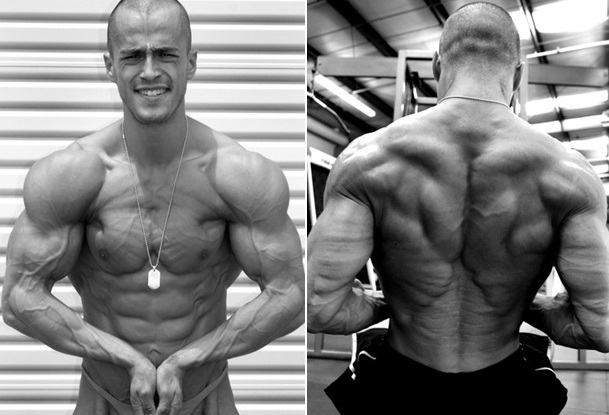How did you get started?
At 16 years of age I started to mess around with weights. All through middle school and high school the culture made me feel as if I was going to some sort of fashion show. The income in my household was somewhat limited, so I decided that if I was not able to buy clothes as nice as the rest of the kids, I was going to try to look better than them regardless. So like many young guys it did stem from some insecurity. Right off the bat I started to really get into it, and in a few months I was a changed man. I started lifting weights shortly after my sophomore year in high school ended, and two months later I came back to school significantly bigger. My classmates noticed the changes right away! Although the positive reinforcement was wonderful and it encouraged me a great deal, it had already turned into passion long before that. I still recall waiting for that last bell to ring so I could hop on that first bus that took me across town to my new iron-sanctuary.
Fast forward 12 years later, and I am still just as hooked as ever, and training is still the part of my day I look forward to most.

You are now a Professional Natural Bodybuilder? What accomplishments are you most proud of?
I will never forget winning my WNBF Pro Card in 2008 at the INBF Capital City Show. A show I had been waiting years to do, and it was great to take the overall as it was my first crack at it. Also I remember my first show, not winning (I finished 3rd out of 4) but accomplishing the feat of going through with the dieting, the training, and getting up on stage. Also, that directly ties-in to meeting Eric Helms who is another one of the masterminds behind Team 3DMJ. It was his first show as well, and since then I have continued to meet so many wonderful people via this sport, including all of the 3DMJ coaches. That has been the coolest part to me; simply meeting many wonderful people over the years.
This is why the coaches and I always look forward to the start of the competitive season. Be it building relationships with all the new trainees, or meeting many new and wonderful people at the shows.
So when you say “what might work for one individual might not work for another”, how so? And how much can people actually vary?
Be it just following “that guy” in your gym’s advice because he’s had success on stage, or a new popular diet going around online, usually you end up trying to put a square peg into a round hole. There is enough variation in individuals’ metabolisms to where the same or similar approach that got one competitor a title, just won’t cut it in order to achieve the same results for another. We all have different caloric needs, and will respond differently to certain macronutrient combinations that go far beyond what any new trendy percentage might recommend. Expecting very extreme results (not that the methods have to be extreme) from your body will require you to split some hairs to find out what is optimal for you.
Case in point: I had a 110 pound female competitor, who was as lean as some of the leanest male competitors you will ever see, on a minimum of 250 grams of carbs a day! And that was just so she would not lose anymore weight! Or another example of a male competitor whose dietary fat percentage had to dropped to below 12% in order to get him ready. More recently, I saw a middle weight competitor who never saw a day with less than 300 grams of carbs and he had shredded glutes.
Sometimes the key to getting that last bit of fat off is not simply cutting calories further. Last year, I had a competitor whose final adjustment was actually a bump in calories and low and behold 10 days later he reported back with a pair of carved hamstrings and striated glutes. In the same respect I have some competitors who I have to take to ketogenic levels of carbohydrates in order for them to get as lean as they want. Some guys that only have to do cardio two times a week, and others that have more cardio sessions than there are days in a week.
But chances are, most folks are somewhere in the middle of all these extremes. But most template diets and protocols have people pushing too far to the right, or too far to the left, and they completely skip over their sweet spot. It’s all about finding what works best for you in the end, which more often than not will differ from your neighbor.

What is your diet like?
Right now I am dieting for a show and my diet has looked like this over the course of the last few months.
Low Days
- 55-65 Fat
- 350-500 Carbs
- 220-275 Protein
High Days (Every 4th Day)
- 55-65 Fat
- 550-700 Carbs
- 200-50 Protein
These have fluctuated depending on what phase of my dieting phase I am on. As far cardio goes, I have kept it at 3-4 sessions per week. Either 4 really short ones anywhere from 15-25 minutes, or 4 longer sessions at about 25-35 minutes. The intensity of my cardio fluctuates depending on what I have lined up that week in the weight room.
On days weeks were I am going for PRs etc, I keep the cardio intensity down. When I am building my lifts back up, it increases a tad.

While on the subject of carbohydrates, I know the amount from person to person can vary, but when is it best to eat them?
Great question, and yes you are correct in that carb intake will vary a great deal from person to person. Insulin sensitivity can differ so much from one person to the next, however, when we need carbs the most doesn’t really differ too much. I would list them in such a manner.
- Pre-Workout
- Breakfast
- Postworkout
- Other times in the day when you need them most: everyday activities that require some moving. Dry walling, coaching little league, if you have an active job for example.
This is how I would prioritize my carbohydrate intake, or intake times. Most people will at some point likely have some very low carb, or even no carb meals. Carbohydrates likely will get dropped as we get deeper into fat loss, so we try to keep the majority around these specific times.
Some people can keep carbs around all meals, others might be limited to some at breakfast, and some preworkout.

What is reverse dieting?
I am not sure if the belief in the “post contest window” is merely an excuse to indulge on everything competitors were not able to during contest prep (ironically often with food they don’t even care for in the offseason!), but one thing is for sure many think this is the most optimal time to make gains. Yes this belief is still roaming around out there: that there is no time to grow like the weeks right after a show. To an extent, this is partially true. You can get bigger, but the majority of the size is going to be fat gain regardless of what the good bros at your gym tell you. I mean let’s look at the situation under the microscope. Metabolically you are not running on all cylinders, hormones are certainly not at full offseason levels, and you have been most likely training under these conditions for a few weeks (at least) now. This is not exactly as ideal as some have made it out to be; in fact most are pretty well burned out after a contest season. How taxed you are varies from person to person; as a guy who lost 35lbs in 20 weeks will have experienced more trauma than one who lost 13lbs in the same amount of time. Recovery time is going to differ from person to person; some people are up and running and nearly completely recovered in 4-6 weeks, while others might take 10-12 weeks to feel “normal” again.I call the “danger zone” where hunger is high and metabolism is low. A great time to put on fat if anything, not muscle. Reverse dieting is slowly adding calories and limiting fat gain.
What are the benefits of reverse dieting? A much leaner physique year round, you can totally stay lean and not have to be at bottom barrel calories year long. You just have to bring food up accordingly, and have some patience.
What is your training routine like?
When it comes to weight training, I have found that WSB helps me add weight to the bar, which is the biggest factor when it comes to putting on muscle. You can’t be lifting the same weights, and reps forever. I have seen some really great gains from this program in the offseason, and it has really helped be during this dieting phase maintain muscle. It’s also a very flexible program, which it needs to be right now that I am dieting, since in some sessions I have cut my volume to half of what you see on my original template.
Sample Routine:
Sunday: DE Bench
- Bench Press 6 x 3 @ 55% 1rm
- CG Bench Press 3 x 6-12/1 Board Bench 3 x 6-12
- Dumbbell Incline Press 3 x 6-12/Dumbbell Floor Press 6 x 12
- Pendlay Rows 3 x 8-12/Braced DB Rows 3 x 8-12
Tuesday: ME Squat/Deadlift
- Squats/Deficit Deadlifts @ 90%
- Barbell Glute Bridge 3 x 10/GHR’s
- Weighted Lower Back Extension
- Weighted Cable Crunches/Leg Raises
- Misc Calves
Thursday: ME Bench
- BB Floor Press/Bench Press@ 90%
- Floor Skull Crushers3 x 10-12/Cable Pushdowns 3 x 10-12
- Shoulder Raises 3 x 8-12
- Pulldowns 3 x 8-12/Weighted Chins 3 x 8-12
- BB or DB Curls 4 x 8-12
Saturday: DE Squat/Deadlift
- Low Box Front Squat/Low Box Back Squat @ 55% 1rm
- Single Leg DB RDL 3 x 8
- DB Split Squats 3 x 8
- Weighted Cable Crunches/Leg Raises
- Misc Calves
Alberto Nunez Clip
How about cardio, how do you manage and decide how much someone needs?
Just like nutrition it will differ, but the rule of thumb is as little as possible. Some individuals might need 6 sessions per week or more, while others might just need to go walk for 30 minutes once or twice a week. From a baseline of cardio we analyze what type of cardio is appropriate. While the amount of cardio is very dependent on how much the individual needs, type of cardio is also very individual. It’s directly correlated to the type of training the person does, as well as their current recovery levels. When you combine the right amount calories, macronutrient composition, the right amount of cardio, and the appropriate cardio intensities, good things happen.
The key is finding this, and this is the part I love the most about coaching. Every person I get is unique from a psychological and physiological standpoint, and will show their own unique variances, my kind of puzzle.

How about when it comes to training? For those of interested in getting ripped, how should our weight training be approached?
Keeping performance up in the gym throughout your whole prep will ensure that you step on stage with all your hard earned muscle. The first mistake I will touch upon is turning weight training time into fat burning time. This is where the athlete actually makes an effort to chew through fat while in the weight room. Let’s get this straight, if there is one time you don’t want to be burning fat, it is while weight training. You should be tapping into fat stores during other times of the day and relying on what you ate while lifting. Adding sets, reps, and lowering rest times in an effort to burn up more calories is not a good idea. On the contrary, smaller, more efficient (aerobically) muscles are better suited for this kind of training…not the adaptations a bodybuilder wants. Lowering work load for the sake of keeping intensity (weight on the bar) up is something I recommend in place of increasing volume and lowering weights.
Let the diet and cardio dictate fat loss, and the weight training is simply there to help you maintain all the hard earned muscle you want to show off.

Any advice you would like to give those who are looking to get ripped, any final words?
Simply put, the common theme here is you need to find what works for you. So you will have to be precise regardless of the approach you take. I love the quote “you can’t manage what you don’t measure”, and if you don’t have a well detailed plan, you will never be able to fully understand what worked or what didn’t. It’s much easier to adjust and change things when you are detailed in your planning. If something does go wrong, you can change it depending on what you feel was causing you to plateau. The same goes with finding something that really hits the spot, if you were detailed and can identify it clearly; well now you have a very important new tool in your tool box.
Precision, consistency, and time, and that is how you find what truly works for you.
Favorite Quote?
“Where there are no men be a man. Even a genius asks questions. Knowledge is the child of confusion.”
Bodyspace: http://bodyspace.bodybuilding.com/FATHERFLEX
Website: http://www.3dmusclejourney.com










